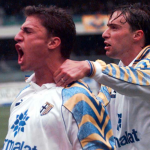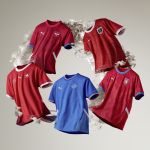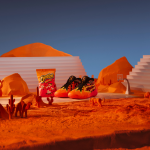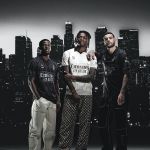
When Parma was sponsored by PUMA
An agreement that returns to prominence thirty years after the first meeting
May 16th, 2023
The myth of Parma at the turn of the 1990s, when the Italian province lived the dream of great European football after years of toil in the lower leagues, is still present in the memory of every football fan over thirty. Despite the bittersweet ending fans experienced with the failures and implosions that followed many of those journeys, it is impossible to separate those champions, those aesthetics and those kits from the golden age of Italian football. When they were promoted to Serie A for the first time in the late 1980s, the Emilians stunned everyone by immediately conquering Europe as a freshly promoted team and then becoming firmly part of the seven sisters who shaped a decade. With the Parmalat sponsor on the chest of the Gialloblù jersey, Calisto Tanzi's team launched an unrepeatable run of talent, lifting trophies in Italy and abroad in quick succession.
After winning the Uefa Cup in 1995 thanks to a double victory over Juventus Torino, the following season Parma changed technical sponsors after a decade, switching from Umbro to PUMA. The German brand immediately entered into a special relationship with Gialloblù and the result did not disappoint expectations. The result did not disappoint expectations. In fact, the design chosen for the jersey of the 1995/96 season immediately became part of the club's legend, thanks to its perfect balance between modernity and tradition with its acrylic colours forming the pattern on the sleeves and shoulders and the laced polo collar. In the centre of the jersey, of course, is the Parmalat logo, which had become a sponsor and synonym for the yellowand blue for a decade. The home jersey is as white as a glass of milk, the away jersey yellow and the third jersey electric blue, with the dominance of the collar changing accordingly. A diamond pattern tone-on-tone was also used to create further movement in the body area.
A kit that was worn on the pitch by Ballon d'Or holders Hristo Stoičkov and Gianfranco Zola, as well as young Fabio Cannavaro, Filippo Inzaghi and Gigi Buffon, and launched a generation that would make Italian football history. And as was so often the case in those years, the jerseys were retained for the following season. The only change was the third jersey, which turned orange when Carlo Ancelotti sat on the ducal bench, replacing Nevio Scala after seven years. Led by the Enrico Chiesa - Hernan Crespo duo, the Gialloblù achieved the best result in their Serie A history, a second-place finish behind Juventus, and sparked a rivalry that would also affect the Ducal club's jersey. For the 1997-98 season, PUMA produced more traditional jerseys, retaining the collar but without buttons, and the colours of the first jersey, still blue on a white background with yellow details. For the second jersey, PUMA united the colours yellow and blue, as they had not done for a few years at Parma, bringing to life an association that from then on would become the soul of the Ducali, who had just decided to stop wearing white in the home version to distinguish themselves from the hated Juventus. First Lotto and later Champions introduced the yellow and blue horizontal stripes that would define Parma's aesthetic in the early 00s.
But PUMA also helped write Parma's history through its goalkeeper's jerseys, which in the Emilian city means Gianluigi Buffon's jerseys. The extreme defender made his debut when he was not even of age and immediately made a name for himself in his first season as a regular in the Gialloblù, also thanks to the jerseys he wore. The first and now historic jersey is the red long-sleeved jersey with dark blue details and the Parmalat flower as a pattern in the centre of the jersey. Even more beautiful were the jerseys of the following year with a hexagonal pattern reminiscent of beehives, both in red and dark blue and in green and blue. Perfect examples of the ingenuity and boldness of goalkeeper jerseys in the 1990s, which could be back in the spotlight thanks to the new agreement between Parma and PUMA, which will debut next year almost thirty years after the first match.



























